Why Your Business Needs More Than Just an Alarm System
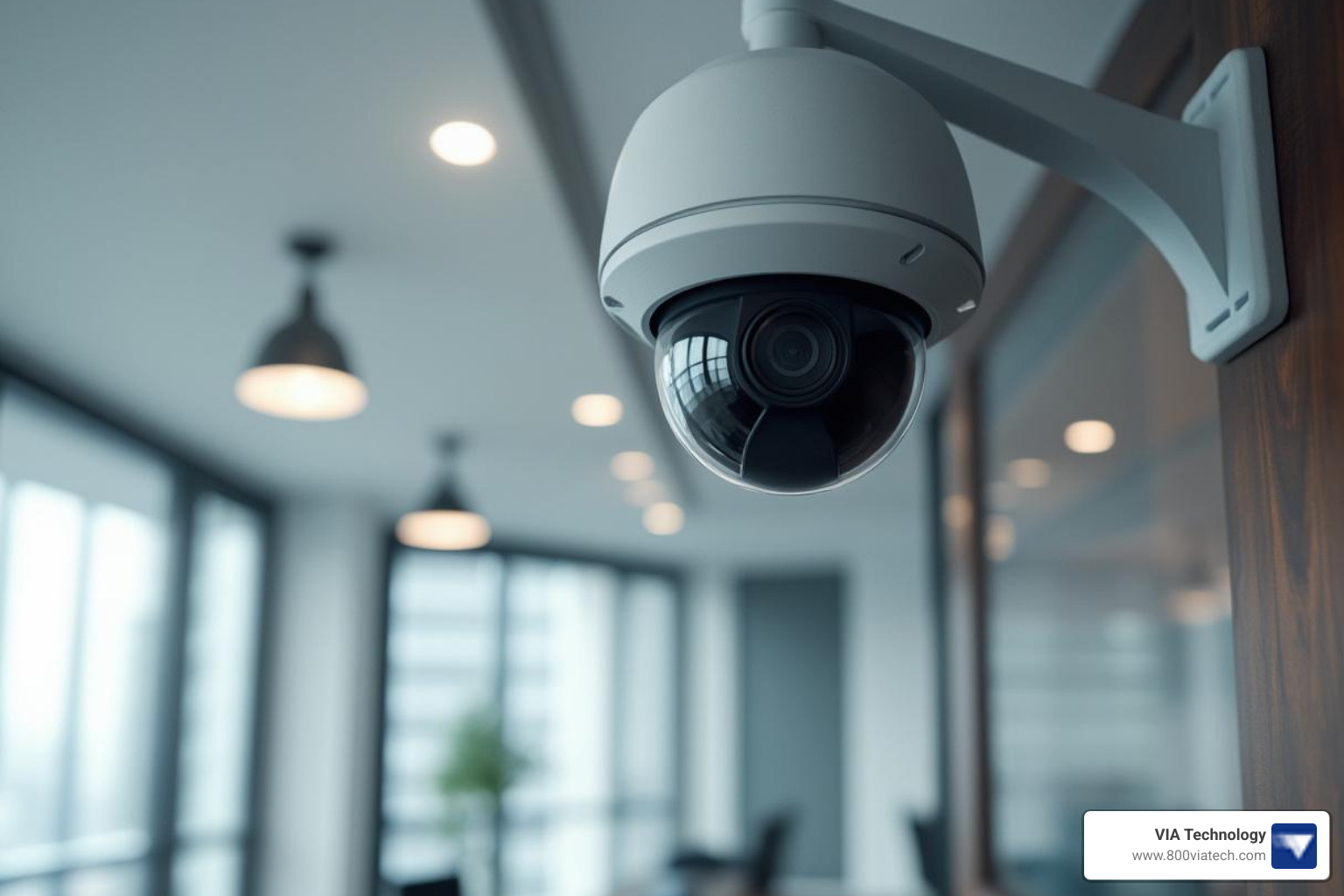
Choosing the right internal cctv camera system is vital for modern businesses. It's about protecting assets, ensuring employee safety, and gaining crucial oversight. When looking for the best internal CCTV cameras for your business, consider these primary types:
- Dome Cameras: Ideal for discreet surveillance and wide coverage in offices or retail spaces.
- Bullet Cameras: Great as a visible deterrent and for monitoring specific long-range areas like warehouses or entry points.
- PTZ (Pan-Tilt-Zoom) Cameras: Perfect for active monitoring of large, dynamic spaces such as construction sites or parking lots.
- Covert Cameras: Used for highly sensitive areas where hidden surveillance is required, such as cash rooms.
Today's business environment demands advanced internal security measures that go beyond a simple alarm system. These cameras offer more than just recording; they provide peace of mind and actionable insights.
They help deter theft, prevent internal fraud, improve employee safety, and allow you to monitor productivity and gather evidence for any incidents. This is especially true for remote worksite management in the construction sector.
As Manuel Villa, President and CEO of VIA Technology, I've seen how crucial advanced internal cctv camera systems are for securing modern business operations. Our expertise in low-voltage cabling and video surveillance has been key in delivering reliable solutions for complex IT projects in the IoT construction sector.
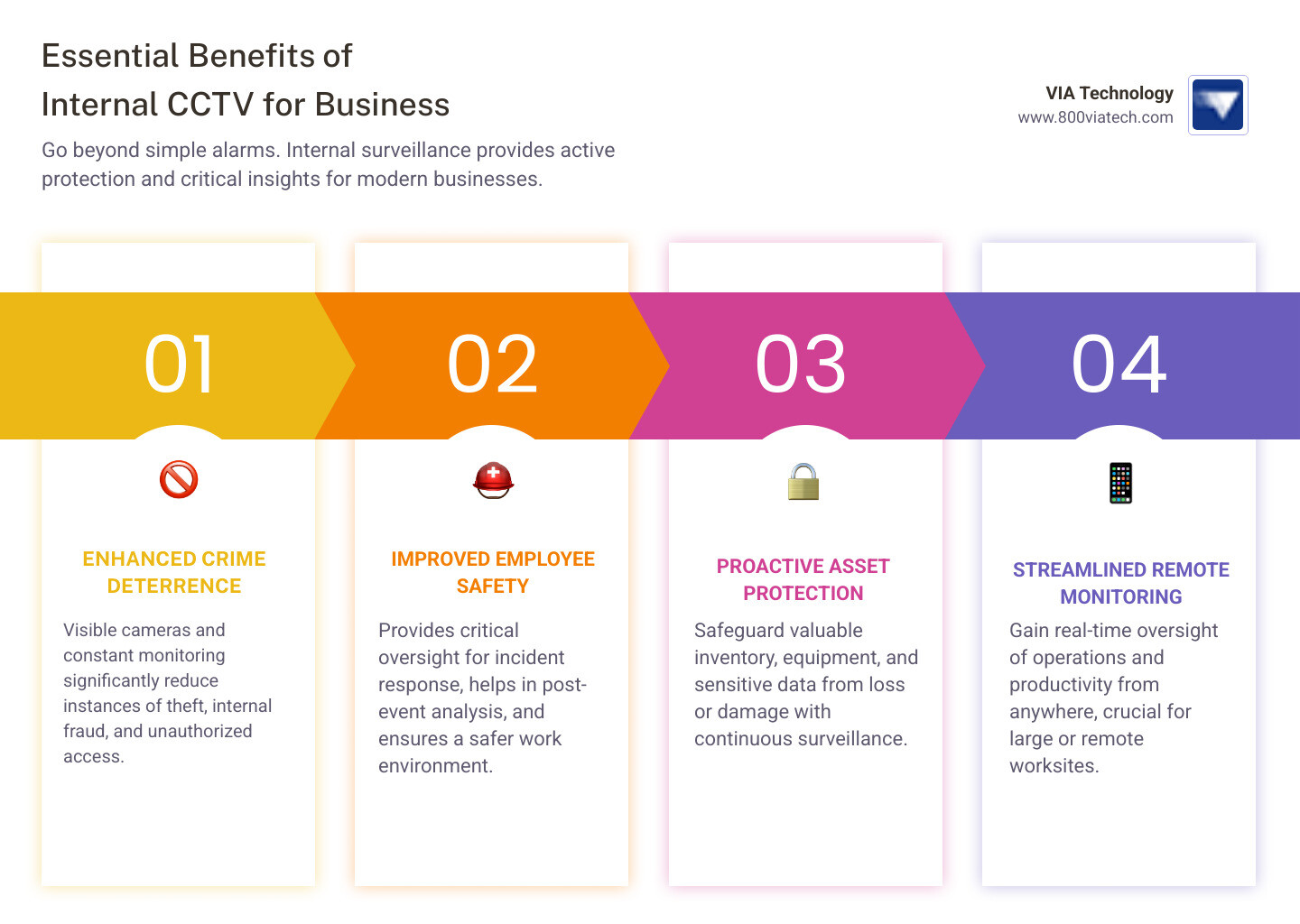
A robust internal CCTV system offers a multi-faceted approach to security that actively protects your business. The global market for CCTV cameras is projected to reach $11.5 billion by 2025, reflecting the growing awareness of the need for comprehensive security and remote monitoring in commercial spaces.
An alarm system only tells you after a breach has occurred. An internal cctv camera system, however, can deter potential threats, provide real-time monitoring, and capture irrefutable evidence. This is invaluable for preventing internal fraud, which can be more damaging than external theft. By having eyes on critical areas, you can significantly reduce the risk of employee theft or unauthorized access to sensitive information.
Furthermore, these systems improve employee safety. In an emergency, footage provides critical information for responders and helps in post-incident analysis. For sprawling construction sites, remote monitoring allows project managers to watch over valuable equipment, materials, and worker activity from anywhere. This remote oversight is a game-changer for efficiency and accountability.
An internal cctv camera system provides a layer of operational insight that an alarm system cannot. It's about proactive protection, not just reactive alerts. For more in-depth information on how we can secure your business, explore our Security Services.
Choosing the Right Type of Internal CCTV Camera
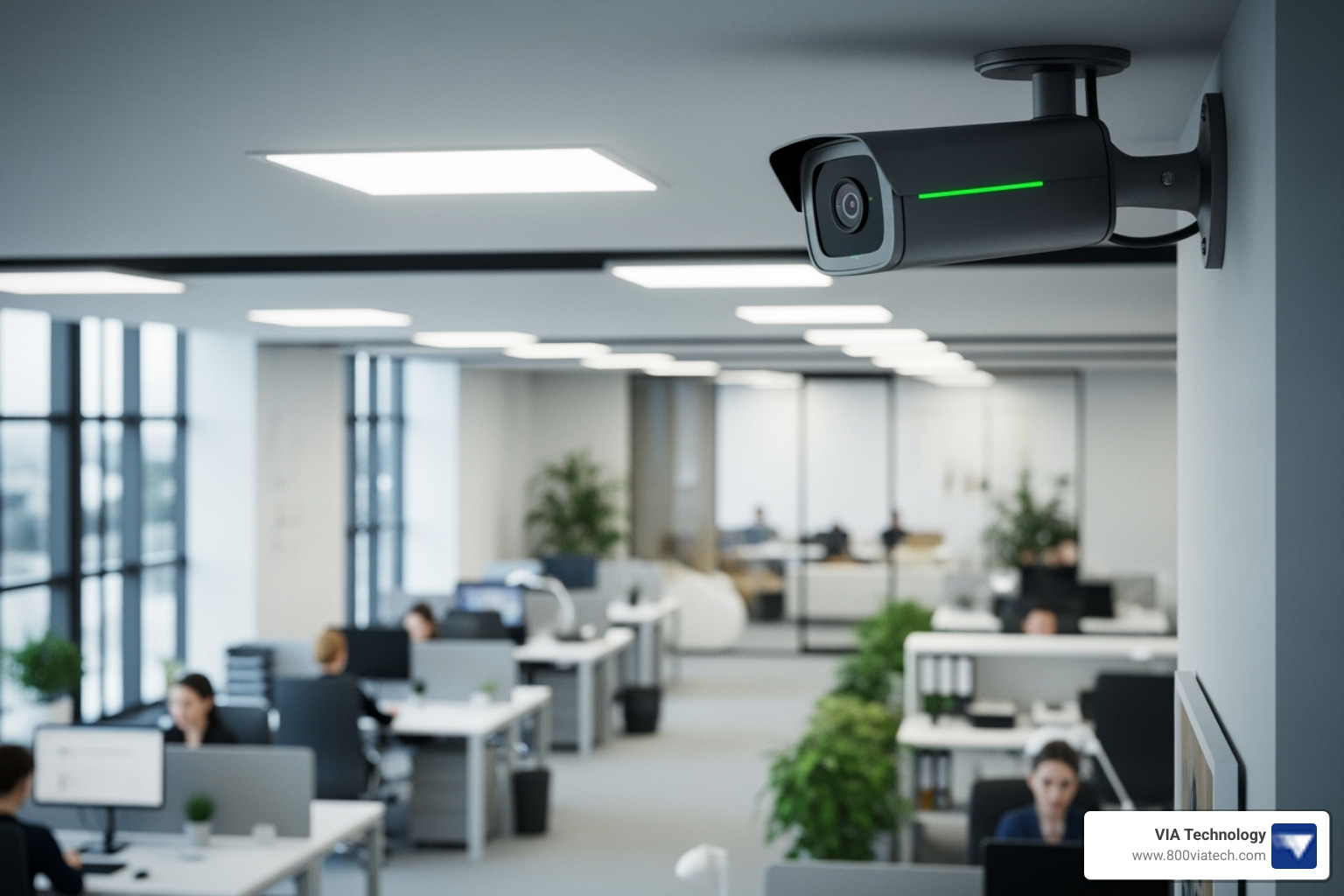
Finding the perfect internal cctv camera for your business means choosing the right tool for the job. A camera that works in a corporate office might be wrong for a busy construction site. Your choice should match your business needs, location, and desired coverage area.
A construction manager on a sprawling job site has different security needs than a retail store owner. The key is understanding which camera type delivers the best results for your unique situation.
Dome Cameras
Dome cameras feature a sleek, unobtrusive design that blends into professional environments like offices, retail spaces, and lobbies. They are ideal where maintaining a welcoming atmosphere is as important as security.
Many dome cameras have vandal-resistant housing. The dome shape makes it difficult to tell which direction the camera is pointing and hard to tamper with, acting as a powerful deterrent.
They can also offer impressive 360-degree coverage, meaning one camera can monitor an area that might otherwise require multiple fixed cameras. This is invaluable for comprehensive coverage in smaller spaces like construction site trailers.
Bullet Cameras
Bullet cameras are a no-nonsense choice. Their distinctive cylindrical shape is highly visible, sending a clear message: "This area is under surveillance." This visibility is a key part of their deterrent effect.
These cameras excel as a visible deterrent in warehouses, loading docks, and entry points. Their straightforward design also makes them relatively easy to install and maintain.
Bullet cameras are champions of long-range viewing. For monitoring a long corridor in a construction facility or equipment at the far end of a warehouse, bullet cameras deliver focused, distant coverage, often with superior night vision.
PTZ (Pan-Tilt-Zoom) Cameras
For ultimate flexibility, PTZ cameras offer remote control to pan horizontally, tilt vertically, and zoom in on details. This sophisticated technology provides dynamic coverage for large areas.
PTZ cameras shine in large, dynamic environments like construction sites, expansive parking lots, and massive warehouses. One PTZ camera can do the job of multiple fixed cameras by actively following activity or patrolling predetermined routes.
For construction managers, PTZ cameras are particularly valuable for monitoring equipment movement, worker safety, and different site areas from a central location. The zoom capabilities can read equipment serial numbers or license plates from a distance, which is crucial for security.
Covert Cameras
When discretion is essential, covert cameras are designed for hidden surveillance in highly sensitive areas where traditional cameras are inappropriate or where you need to observe uninfluenced behavior.
These specialized internal cctv camera systems often have tiny pinhole lenses or are disguised as everyday objects. They are typically used in cash rooms or supply closets to investigate specific security concerns without alerting personnel.
Some covert cameras use PIR motion sensors to record only when movement is detected, saving storage space and making footage review more efficient. However, covert surveillance has significant legal and ethical considerations that must be carefully managed.
Each camera type has its strengths. Understanding your business environment and security goals will guide you to the right choice or, more likely, the right combination of cameras for comprehensive coverage.
Key Features to Demand from Your Business Surveillance System
When choosing an internal cctv camera system, its about more than just the camera. Its about selecting the right technology and features to protect your business and streamline operations. A top-notch system requires strong components, clear technical specifications, and a future-ready design. Want to dive deeper? Check out The Ultimate Guide to Choosing CCTV Surveillance Cameras.
Resolution and Connectivity
Image clarity is critical for surveillance footage. Higher resolution provides more detail, which is key for identifying people, reading license plates, or understanding events. While 1080p Full HD is common, modern business cameras offer sharper options like 2K, 4K Ultra HD, and 12MP resolutions. Higher resolutions allow you to zoom in without losing clarity, which is crucial when reviewing an incident. Also consider the field of view; wide-angle lenses are excellent for covering large spaces.
Connectivity is another major factor. The choice is generally between IP (Internet Protocol) and Analog cameras. While older analog systems used coaxial cables and had lower resolution, modern IP cameras send high-resolution digital signals over your network, offering more advanced features and flexibility. For businesses, IP cameras are almost always the better choice. They often use Power over Ethernet (PoE), which provides both power and data through a single cable. This simplifies installation and reduces cabling costs, a huge benefit for large construction sites or office buildings. Plus, IP cameras integrate seamlessly into existing IT networks, which is where our expertise in Networking Systems shines.
Storage and Access
Once you capture footage, you need a reliable and secure way to store and access it. The main options are on-site Network Video Recorders (NVRs) or Digital Video Recorders (DVRs), often supplemented with cloud backup for added security.
NVRs pair with IP cameras to record digital video streams from your network. They typically include large hard drives (2TB or 4TB) that can hold weeks or months of continuous video. Some cameras also have local storage via microSD cards, which is useful for backup or smaller setups. The benefit of local storage is that there are no monthly fees, and your data remains on-site.
Cloud backup provides an off-site copy of crucial footage, protecting data from on-site theft, damage, or disaster. Cloud storage also enables easy remote access, allowing authorized team members to view live or recorded video from anywhere. For managers overseeing a construction site from afar, this remote access is vital. When considering storage, always prioritize strong data security like encryption to protect sensitive footage. For more help choosing, our guide on Choosing the Right Video Surveillance System for Your Business is a great resource.
Advanced Capabilities for a Smarter Internal CCTV Camera
Today's internal cctv camera systems are smart tools that can significantly boost your business's security.
Infrared (IR) Night Vision is essential for 24/7 surveillance, especially after hours or in dimly lit areas like warehouses or server rooms. IR LEDs allow cameras to capture clear black-and-white video in total darkness, with some advanced models seeing for hundreds of feet.
AI-Powered Analytics turns raw video into actionable information. Features like person detection reduce false alarms by distinguishing people from other movements. Facial recognition can identify authorized staff, while line-crossing detection can alert you if someone enters a restricted area. These analytics help your security team focus on real threats.
With Two-Way Audio, you can communicate directly through the camera system. This feature can be used to deter trespassers, give instructions to delivery drivers, or check in with employees, adding an interactive layer to your surveillance.
Smart Alerts work with AI analytics to send real-time notifications to your phone or monitoring station when specific events occur. Whether its unusual after-hours activity or an unauthorized person in a sensitive zone, timely alerts enable a fast response, minimizing potential risk.
These advanced features make today's internal cctv camera systems a crucial part of a comprehensive business security plan, offering intelligence that older systems cannot match.
Installation, Privacy, and Legal Compliance
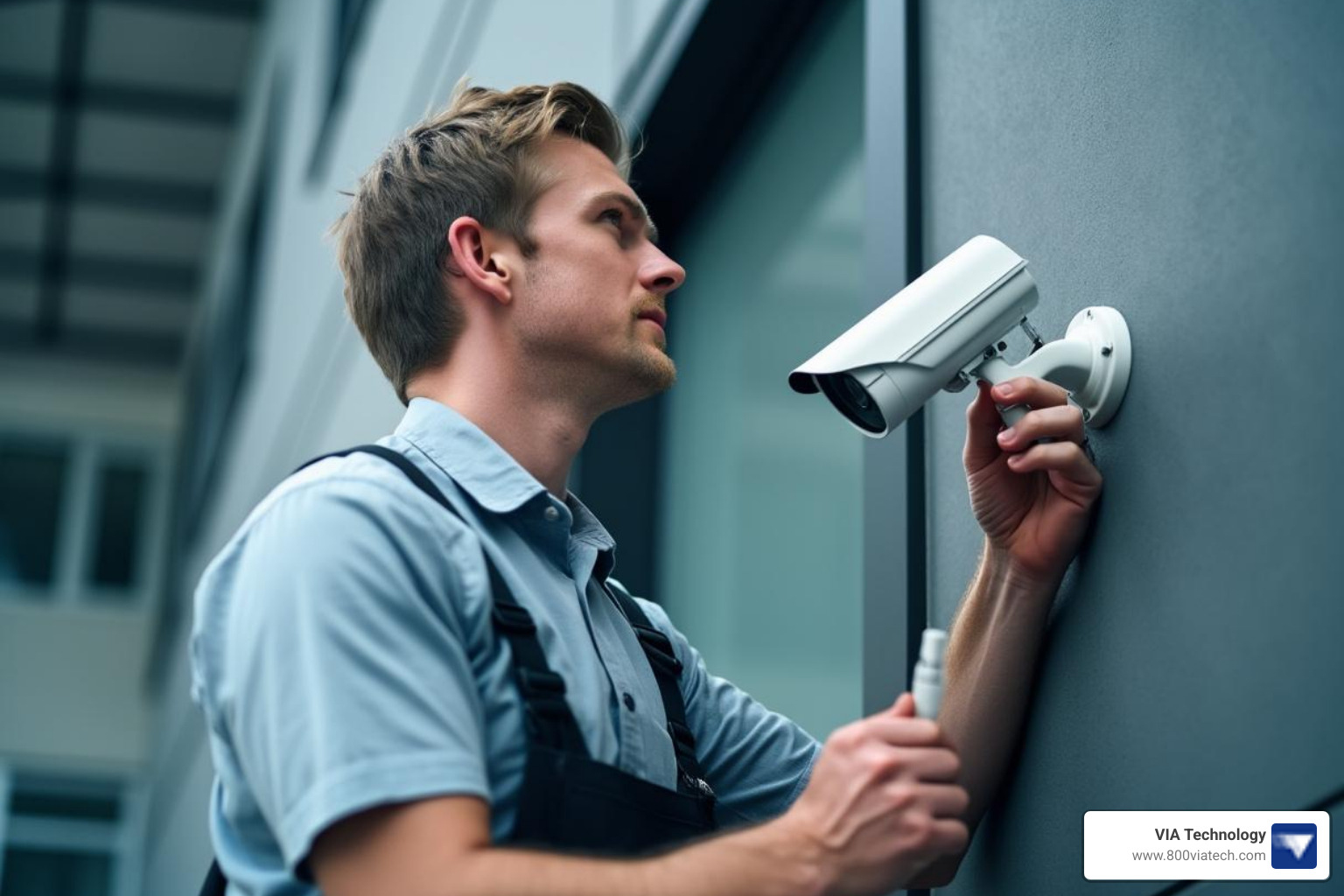
Choosing the right internal cctv camera system is a huge step, but effective implementation involves more than just plugging it in. Proper installation, respecting privacy, and ensuring legal compliance are critical. At VIA Technology, we understand these details for commercial and industrial settings, ensuring your system is both effective and compliant.
Professional Setup vs. DIY
While DIY installation is tempting, business-grade internal cctv camera systems, especially for large spaces like construction sites or multi-floor offices, are far more complex than home cameras.
Reliable connections, like Power over Ethernet (PoE) for IP cameras, require careful planning. Cables must be routed correctly and protected for consistent performance. Integrating cameras into your existing IT network also requires specialized knowledge to avoid slowing down your network or creating security risks.
Professional installers ensure system reliability. They plan camera placement to eliminate blind spots and ensure continuous operation. Our team at VIA Technology specializes in IT and IoT integration, managing projects from design to support. We ensure your new internal cctv camera system integrates perfectly with existing setups like access control or alarm systems. This professional approach saves you headaches and money, ensuring your security is always on point.
Workplace Privacy and Texas Law
Using internal cctv camera systems in the workplace requires balancing security with employee privacy. In Texas, as in other states, businesses must follow clear rules about surveillance.
Generally, businesses can monitor areas without a "reasonable expectation of privacy," such as lobbies, hallways, and open office areas. However, areas where privacy is expected, like restrooms and locker rooms, are typically off-limits for video surveillance.
It is also important to notify employees that they are being monitored. Audio recording is more complex. While Texas is a "one-party consent" state for audio, using it for general surveillance can create legal risks for businesses. Many companies avoid audio recording to prevent legal issues. If audio is necessary, clear policies and explicit consent are crucial.
Finally, you need a data handling plan for the footage you collect, including who can view it, how long it's stored, and how it's secured from unauthorized access. We always recommend consulting with legal counsel to review your specific surveillance plans and ensure compliance with all state and federal laws. Our goal is to help you set up a security system that's effective, ethical, and fully legal.
Frequently Asked Questions about Business Security Cameras
Here are answers to common questions we hear from Texas businesses, especially in construction and commercial sectors, about internal cctv camera systems.
What are the key differences between a consumer and a commercial internal cctv camera?
Consumer-grade cameras are not built for the demands of a business environment, a mistake that often costs more in the long run.
- Durability: Commercial cameras are engineered for 24/7 operation and can withstand the temperature changes, dust, and wear of a busy work environment. Consumer cameras are designed for controlled indoor conditions.
- Scalability: Commercial systems allow you to add cameras seamlessly as your business grows or as you manage multiple construction sites from one central location. Consumer systems are not designed for large deployments.
- NVR/DVR Integration: Commercial cameras integrate with powerful recording systems that store weeks of high-resolution footage. Consumer cameras often rely on limited cloud storage with monthly fees.
- Advanced Analytics: Commercial systems offer features like people counting and behavior detection that integrate with business intelligence tools. Consumer cameras typically offer only basic motion alerts.
- Compliance Features: Commercial systems include encryption, secure access controls, and audit trails to help meet regulatory requirements and protect sensitive data.
Can I integrate security cameras with other systems like access control?
Yes. Modern internal cctv camera systems are not isolated; they are part of a connected security ecosystem that makes business operations smoother and more secure.
- Unified Security: Your systems can communicate with each other. For example, when someone badges into a restricted area, cameras can automatically start recording. If motion is detected in an empty area, the access control system can lock nearby doors.
- Centralized Management: Instead of multiple interfaces, a single dashboard can show camera feeds, door status, and alarm conditions. This is invaluable for construction project managers who need to monitor equipment, safety, and site access from one location.
- Automated Responses: The system can react automatically to events. For instance, if a camera detects an intruder after hours, it can trigger floodlights, send alerts, and record in high definition without human intervention.
Our expertise in Access Control systems means we can design these integrated solutions from the ground up, ensuring seamless operation.
Are wireless cameras reliable enough for a commercial environment?
Businesses often ask about wireless cameras to avoid complex cabling. While it depends on specific needs, for most commercial applications, wired systems remain the superior choice.
- Wired Reliability (PoE): Power over Ethernet (PoE) is the gold standard, delivering power and data through one cable for a rock-solid connection. This consistency is crucial for construction sites and office buildings where security gaps are unacceptable.
- Wi-Fi Interference: In commercial environments, numerous wireless devices, metal structures, and concrete walls can disrupt Wi-Fi signals, making wireless cameras unreliable.
- Bandwidth Limitations: Multiple high-resolution cameras can overwhelm a wireless network, affecting both security and general business operations.
- Battery Dependence: Battery-powered cameras require regular maintenance and risk going offline at a critical moment.
However, hybrid solutions can be effective. We might recommend wireless cameras for temporary monitoring (like changing construction site perimeters) while using wired cameras for permanent, critical areas. The key is a custom design that matches your operational needs.
Conclusion: A Proactive Approach to Business Security
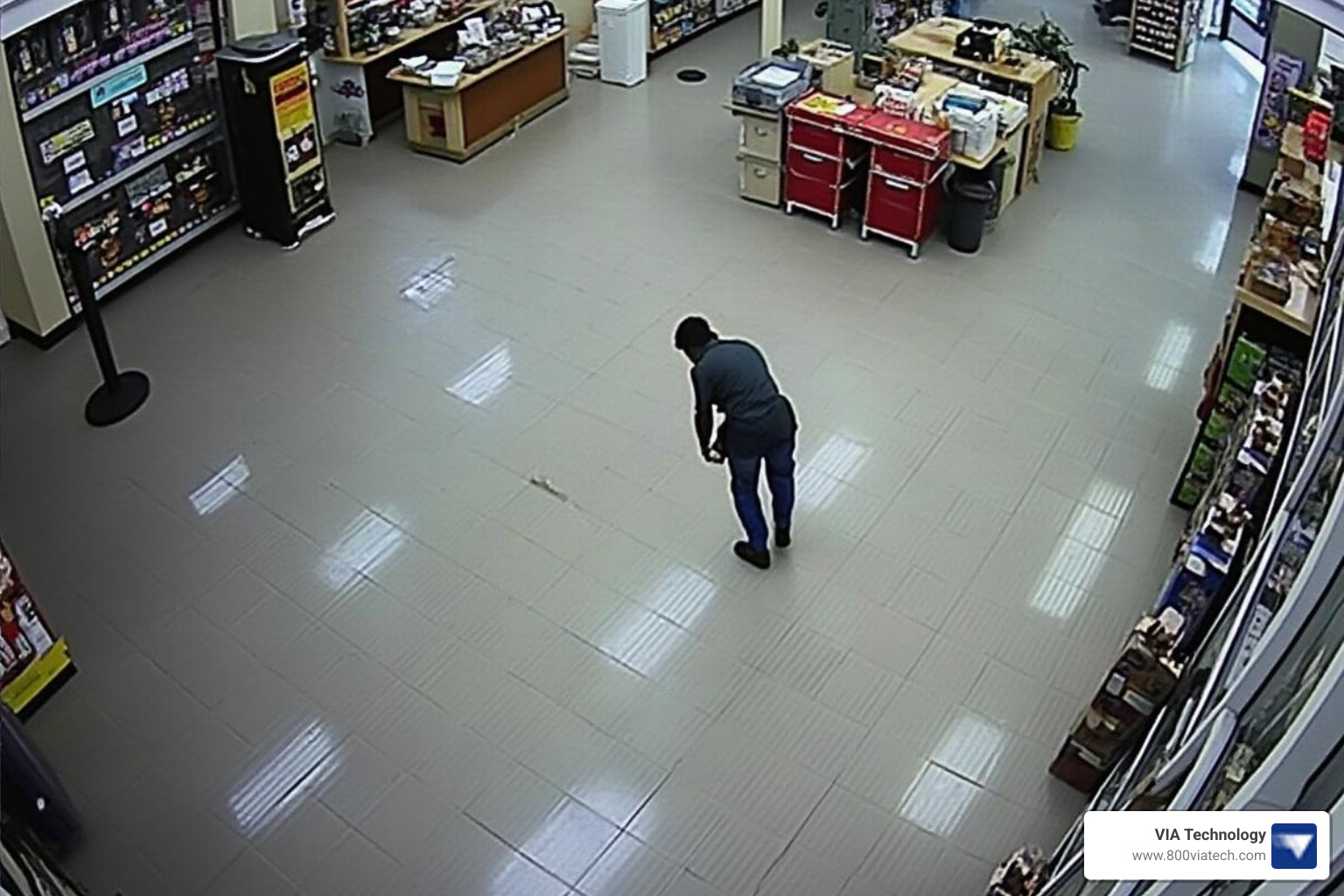
In today's business world, proactive security is essential. A robust internal cctv camera system is a must-have tool for protecting your business and ensuring smooth operations. These systems do more than just record; they deter theft, improve team safety, and provide valuable operational insights, especially for managing construction sites remotely.
We've covered various camera types, from discreet dome cameras for offices and visible bullet cameras for deterrence, to dynamic PTZ cameras for large areas and covert cameras for sensitive locations. Each offers unique benefits.
Beyond the hardware, a smart surveillance system requires high-resolution imaging, reliable PoE connectivity, and secure storage options, both local and cloud-based, for remote access. Advanced AI-powered analytics transform cameras from simple viewers into intelligent tools that can understand and alert you to important events.
Furthermore, professional installation is critical to ensure system reliability. Understanding and adhering to privacy regulations, particularly in Texas, is also essential for legal compliance and building trust.
Choosing the right internal cctv camera system is a major decision affecting your security, operations, and peace of mind. There is no one-size-fits-all answer; the goal is a custom solution custom to your unique business needs, physical space, and legal requirements.
That's where VIA Technology comes in. We specialize in creating complete video surveillance solutions that integrate seamlessly with your existing IT and IoT systems. From initial design and professional setup to 24/7 monitoring and ongoing support, we are here for you. Our goal is to ensure your system runs smoothly, saving your business time and money, whether you're in San Antonio or anywhere else across Texas.
Don't wait for an incident to occur. Be proactive. Protect your assets, team, and operations with a smart, reliable internal cctv camera system. Ready to craft a security solution that's right for you? Dive deeper into our comprehensive Video Surveillance & Security Cameras offerings today!


